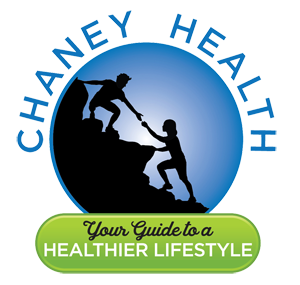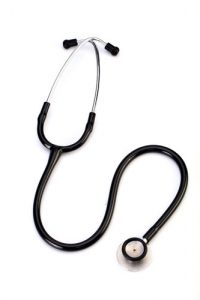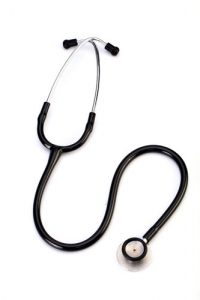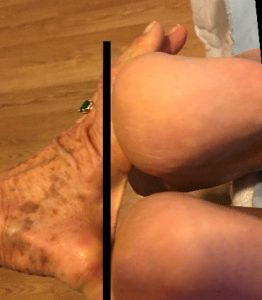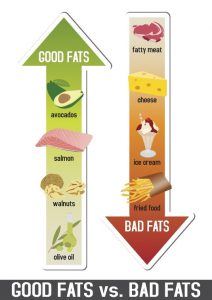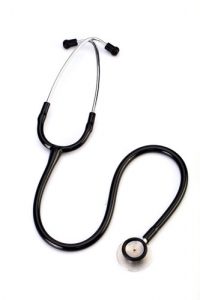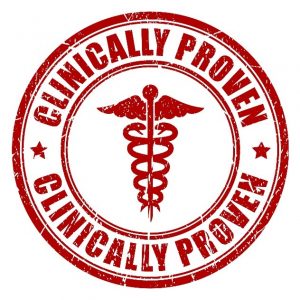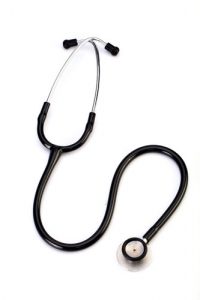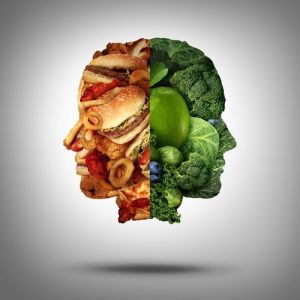Is The Paleo Diet Bad For Your Gut?
 There is a lot to like about the Paleo diet:
There is a lot to like about the Paleo diet:
· It is a whole food diet. Any diet that eliminates sodas, junk foods, and highly processed foods is an improvement over the American diet.
· It includes lots of vegetables and some fruits.
· It helps you lose weight, and any diet that results in weight loss improves your blood work – things like cholesterol, triglycerides, blood sugar control and more.
However, there are concerns the Paleo diet may not be healthy long term.
· In part, that is because the diet is high in meat, red meat, and saturated fat.
· Equally important, however, is what the diet eliminates – namely whole grains, legumes (beans), and dairy.
Those of you who have read my book, “Slaying The Food Myths”, know that I say: “We have 5 food groups for a reason”. This is particularly true for the plant food groups. That’s because each plant food group provides a unique blend of:
· Vitamins and minerals. Those can be replaced with good multivitamin/multimineral supplement.
· Phytonutrients. You can only get the full complement of health-promoting phytonutrients from a variety of foods from all 5 food groups.
· Fiber. There are many kinds of fiber and they each play different roles in our intestine. You can only get all the health-promoting varieties of fiber by consuming fruits, vegetables, whole grains and legumes.
· Gut bacteria. What we call fiber, our gut bacteria call food. Each of the plant food groups supports different populations of friendly gut bacteria.
Based on this reasoning, one might suspect that the Paleo diet might alter our gut bacteria in ways that could be bad for our health. Until recently, this sort of reasoning was just a theoretical concern. That’s because:
1) We knew far too little about the health effects of different populations of bacteria. This is rapidly changing. Several recent studies have systematically investigated the connection between gut bacteria and health outcomes.
2) We knew our diet influenced the bacteria populations found in our gut, but we had no understanding of how these changes might influence our health. This too is changing. The study (A Genoni et al, European Journal of Nutrition, https://doi.org/10.1007/s00394-019-02036-y) I discuss this week is an excellent example of recent studies linking diet, gut bacteria, and risk factors for disease.
How Was The Study Done?
 This study recruited 91 participants from Australia and New Zealand. It was a very well designed study in that:
This study recruited 91 participants from Australia and New Zealand. It was a very well designed study in that:
· The Paleo diet group (44 participants) was recruited based on self-proclaimed adherence to the Paleo diet (< 1 serving/day of grains and dairy products) for one year or more. This is important because short term effects of switching to a new diet are confounded by weight loss and other factors.
o After analyzing the diets of the Paleo group, the investigators found it necessary to subdivide the group into Strict Paleo (< 1 serving/day of grains and dairy products) and Pseudo-Paleo (> 1 serving/day of grains and dairy).
· The control group (47 participants) was recruited based on self-proclaimed adherence to a “healthy diet” for 1 year or more with no change in body weight (A healthy diet was defined as a whole food diet containing a variety of foods from all 5 food groups). This is important because far too many studies compare the diet they are promoting to an unhealthy diet with a lot of sugar and highly processed junk foods. These studies provide little useful information because almost anything is better than an unhealthy diet.
· The participants completed a diet survey based on the frequency of consumption of various foods during the previous year. However, because diet surveys based on the recollection of participants can be inaccurate, the investigators used two rigorous tests to validate the accuracy of those diet surveys.
o The first was a 3-day weighed dietary record (WDR). Simply put, this means that participants weighed and recorded all foods and beverages before they were eaten for 3 days. Two of those days were weekdays, and one was a weekend day.
o Secondly, the investigators used blood, urine, and metabolic measures to independently determine protein and energy intake of each participant. Participants who were identified by these means as under reporting both protein and energy were considered unreliable dietary reporters and were excluded from the analysis.
o It is very rare to find a study that goes to this length to validate the accuracy of the dietary data used in their analysis.
The participants also provided blood, urine and stool samples and completed a physical activity assessment.
What Were The Differences Between The Paleo Diet And The Healthy Control Diet?
 Only the Strict Paleo Diet group was faithfully following the Paleo diet. In addition, most of the results with the Pseudo Paleo Diet Group were intermediate between the other two diets. Therefore, to simplify my discussion of this study I will only compare the Strict Paleo Diet group, which I refer to as the Paleo Diet group, with the Healthy Diet control group.
Only the Strict Paleo Diet group was faithfully following the Paleo diet. In addition, most of the results with the Pseudo Paleo Diet Group were intermediate between the other two diets. Therefore, to simplify my discussion of this study I will only compare the Strict Paleo Diet group, which I refer to as the Paleo Diet group, with the Healthy Diet control group.
The Paleo diet emphasizes fresh vegetables, especially green leafy vegetables, and discourages grains. Thus, it is no surprise that:
· The Paleo Diet group ate 74% more vegetables and 3 times more leafy green vegetables than the Healthy Diet group.
· The Paleo Diet group ate only 3% of the grains and 3% of the whole grains compared to the Healthy Diet group.
The Paleo diet encourages consumption of meat and eggs and discourages consumption of dairy and plant proteins. Thus, it is not surprising that:
· The Paleo Diet group ate 3 times more red meat and 5 times more eggs than the Healthy Diet group.
· The Paleo Diet group ate 10% of dairy foods compared to the Healthy Diet group.
· The Paleo Diet group consumed two times more saturated fat and cholesterol than the Healthy Diet group.
The most interesting comparison between the two diets was the following:
· Intake of total fiber, insoluble fiber, and soluble fiber was comparable on the two diets.
· However, intake of resistant starch was 50% lower in the Paleo Diet group. This is significant because:
o Resistant starch is a type of fiber found primarily in whole grains, legumes, potatoes, and yams (Potatoes and yams are also dietary “no nos” on most low-carb diets).
o Resistant starch is an especially good food for certain species of healthy gut bacteria.
Is The Paleo Diet Bad For Your Gut?
 Because resistant starch affects gut bacteria, the study next looked at the effect of the two diets on the populations of gut bacteria. This is where the story starts to get interesting. When they looked at different groups of gut bacteria, they discovered that:
Because resistant starch affects gut bacteria, the study next looked at the effect of the two diets on the populations of gut bacteria. This is where the story starts to get interesting. When they looked at different groups of gut bacteria, they discovered that:
· Bifidobacteria were much more abundant in the Healthy Diet group than in the Paleo Diet group, and the amount of Bifidobacteria in the gut was directly proportional to the amount of whole grains in the diet.
o This is important because previous studies have suggested Bifidobacteria help maintain intestinal barrier integrity and protect against irritable bowel syndrome and obesity.
· Roseburia were also much more abundant in the Healthy Diet group and proportional to the amount of whole grains in the diet.
o This is important because previous studies have suggested Roseburia protect against inflammatory bowel diseases like Crohn’s disease and ulcerative colitis.
· Hungatella were much more abundant in the Paleo Diet group and were inversely proportional to the amount of whole grains in the diet.
o This is important because Hungatella metabolize carnitine and choline, which are found in meats (especially red meats), egg yolks, and high fat dairy, into a compound called trimethylamine or TMA. TMA is then further metabolized in the liver to trimethylamine-N-oxide, or TMAO.
o TMAO is a bad player. It is positively associated with heart disease, stroke, kidney disease, diabetes, and Alzheimer’s disease. However, the evidence is strongest for heart disease. TMAO has been called an independent risk factor for cardiovascular death.
Because of this, the study looked at TMAO levels in the blood of the two diet groups. These results were concerning:
· TMAO levels were 2.5-fold higher in the Paleo Diet group than in the Healthy Diet group.
· As might be expected, TMAO levels were positively correlated with red meat intake and inversely proportional to whole grain intake.
Is The Paleo Diet Bad For Your Heart?
 When you put all the evidence together you have a compelling argument that the Paleo diet is likely to increase the risk of heart disease. Let me summarize the data briefly:
When you put all the evidence together you have a compelling argument that the Paleo diet is likely to increase the risk of heart disease. Let me summarize the data briefly:
1) The Paleo diet discourages the consumption of whole grains.
2) Whole grains are a major source of a dietary fiber called resistant starch.
3) Because the Paleo diet is low in resistant starch, it causes a decrease in two healthy types of gut bacteria and an increase in a type of gut bacteria called Hungatella.
4) Hungatella metabolize compounds found in meat, eggs, and dairy to a precursor of a chemical called TMAO. This study showed that TMAO levels were 2.4-fold higher in people consuming a Paleo diet.
5) TMAO is associated with coronary artery disease and is considered an independent risk factor for cardiovascular death.
The authors of the study concluded: “Although the Paleo diet is promoted for improved gut health, results indicate long-term adherence is associated with different gut microbiota and increased TMAO. A variety of fiber components, including whole grain sources, may be required to maintain gut and cardiovascular health.”
Of course, studies like this are looking at associations. They are not definitive. What we need are long term studies looking at the effect of the Paleo diet on heart disease outcomes like heart attack and stroke. Until we have these studies my advice is:
· Don’t accept claims that the Paleo diet is heart healthy. There are no long-term clinical studies to back up that claim.
· Be aware that the Paleo diet affects your gut bacteria in ways that may be bad for your heart.
The more we learn about our gut bacteria, the more we appreciate the importance of including all 5 food groups in our diet, especially all the plant food groups.
Are Low Carb Diets Healthy?
 The Paleo diet is not the only diet that is high in red meat and low in whole grains. The same is true for virtually all the popular low-carb diets. There are studies showing other low-carb diets also alter gut bacteria and raise TMAO levels, so there is a similar concern that they may also increase the risk of heart disease.
The Paleo diet is not the only diet that is high in red meat and low in whole grains. The same is true for virtually all the popular low-carb diets. There are studies showing other low-carb diets also alter gut bacteria and raise TMAO levels, so there is a similar concern that they may also increase the risk of heart disease.
This is in addition to concerns about the high saturated fat consumption which increases the risk of heart disease and red meat consumption, which may increase the risk of certain cancers.
Finally, there are no studies showing that any low-carb diet is healthy long term, even the Atkins diet, which has been around for more than 50 years. Until we have long-term studies about the health consequences of low-carb diets, my advice is similar to that for the Paleo diet.
· Don’t accept claims that low-carb diets are healthy. There are no long-term clinical studies to back up that claim.
· Be aware that low-carb diets affect your gut bacteria in ways that may be bad for your health.
The Bottom Line
A recent study looked at the effect of the Paleo diet on an important risk factor for heart disease. Here is a brief summary of the data:
1) The Paleo diet discourages the consumption of whole grains.
2) Whole grains are a major source of a dietary fiber called resistant starch.
3) Because the Paleo diet is low in resistant starch, it causes a decrease in two healthy types of gut bacteria and an increase in a type of gut bacteria called Hungatella.
4) Hungatella metabolize compounds found in meat, eggs, and dairy to a precursor of a chemical called TMAO. This study showed that TMAO levels were 2.4-fold higher in people consuming a Paleo diet.
5) TMAO is associated with coronary artery disease and is considered an independent risk factor for cardiovascular death.
Of course, studies like this are looking at associations. They are not definitive. What we need are long term studies looking at the effect of the Paleo diet on heart disease outcomes – like heart attack and stroke. Until we have these studies my advice is:
· Don’t accept claims that the Paleo diet is heart healthy. There are no long-term clinical studies to back up that claim.
· Be aware that the Paleo diet affects your gut bacteria in ways that may be bad for your heart.
· Virtually all the popular low-carb diets discourage consumption of whole grains, so my advice for them is the same as for the Paleo diet.
The more we learn about our gut bacteria, the more we appreciate the importance of including all 5 food groups in our diet, especially all the plant food groups.
For more details on the study and what it means for you, read the article above.
These statements have not been evaluated by the Food and Drug Administration. This information is not intended to diagnose, treat, cure or prevent any disease
 Fall is glorious in my book. I was up in New York a few weeks ago, and the trees were just changing – I was about a week too early for the best colors, but it was still beautiful. Then I flew out to Lake Tahoe, and it was really beautiful there. The air was crisp and clean, and I loved all the fall decorations.
Fall is glorious in my book. I was up in New York a few weeks ago, and the trees were just changing – I was about a week too early for the best colors, but it was still beautiful. Then I flew out to Lake Tahoe, and it was really beautiful there. The air was crisp and clean, and I loved all the fall decorations. Weight-bearing exercise builds strong bones. That statement is so common that just about everyone knows they need to exercise for strong muscles and bones, and for all the good it does for just about every system in the body. And, we are what we eat, so nutrition is vital.
Weight-bearing exercise builds strong bones. That statement is so common that just about everyone knows they need to exercise for strong muscles and bones, and for all the good it does for just about every system in the body. And, we are what we eat, so nutrition is vital.
